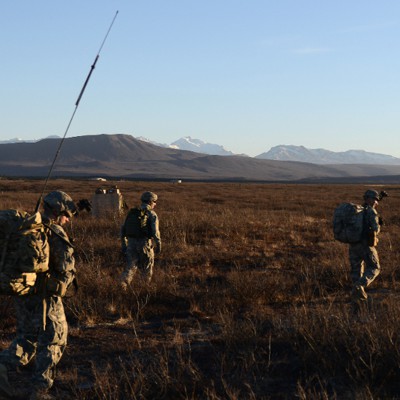For U.S. Army soldiers in the field, the only constant is unpredictability — they must be prepared to deal with a crisis or change of plan at a moment’s notice. When situations arise that require solutions guided by Army Doctrine, soldiers need access to those answers as quickly as possible. As AI-powered tools are integrated into military operations, generative AI (GenAI), in particular, has the potential to transform decision-making processes in the field.
With more than two decades of experience in AI, Leidos is now leveraging emerging GenAI technologies to turn established Army Doctrine documents into GenAI-powered tools.
GenAI in the field
As the body of knowledge and principles that guide the Army’s actions, Army Doctrine contains a vast array of data and information to support mission objectives. The sheer volume of information presents several fundamental challenges: keeping Doctrine updated, developing robust training aligned to Doctrine, and enabling users to find answers in the field. These tasks require a significant level of time and attention.
Traditionally, curating reference materials to support training has required a lot of time-consuming human touch. Meanwhile, Doctrine guidance is constantly changing due to evolving tactics of adversaries. This cycle of updating training, based on updated Doctrine, based on recent cyber knowledge continues to accelerate.
“The military relies heavily on in-person and online training, and once that training is delivered, trained soldiers are expected to retain that knowledge,” said Kevin Chin, director of generative AI at Leidos. “They’re also provided reference material for the future, and it’s important that the soldiers have an easy way to access this knowledge and material.”
Making GenAI solutions available to soldiers is like providing them a copilot — a knowledgeable partner to help humans access information in an easier and more efficient manner. Picture a soldier confronted by an unexpected situation or encounter being able to ask questions about Army Doctrine in natural language and receive answers in real time. This method of interaction is more natural compared to searching for keywords within documentation, commonly performed using functions embedded in online tools.
“We have observed that when you offer that generative AI capability to ask questions and find that material, we’ve seen savings of upwards of 50%,” Chin said.
AI is also valuable in situations when updated information is critical and time sensitive. For example, AI can provide real-time analysis of essential supplies available at different locations, thereby informing and impacting logistical and tactical decisions.
“From material and supplies, all the way through making data like an individual soldier’s allergies available to medical personnel on a battlefield in a very confusing environment,” said Tifani O’Brien, vice president and director of the Leidos AI Accelerator. “These are really important scenarios and, for us, using AI to modernize these existing workflows, we want to establish that human-machine partnership.”
Keeping GenAI secure and trustworthy
Given the sensitivity of the Army’s missions, implementing new technologies into an organization requires a focus on trust, responsibility, and governance. It also requires both a robust methodology and advanced solutions to help users feel comfortable using AI tools that are integrated with their existing business processes.
“It’s not just about the technology, it’s not just about the AI results, but it’s equal emphasis on methodology,” Chin said. “So that at the end, the organization and the users feel comfortable we’re not completely disrupting their business processes.”
To further support seamless integration, Leidos follows a 4A methodology to shape the human-machine relationship, beginning with using AI in the analysis of data and assistance in extracting results, through augmentation of human capabilities, such as managing more data faster than a human could reasonably accomplish, and finally autonomy. The goal is not to replace humans with AI, but to leverage AI as a trusted partner.
“You’re coming in at the right place in the workflow with the right interaction with the human, so they can see and learn and give feedback on how well the AI is working,” O’Brien said. “How do you enable the same human to do more? That’s where we think this AI human-machine partnership really can be of value.”
For tools, “we have a whole suite of tools for deploying trusted, secure AI, which we call FAIRS — Framework for AI Resilience and Security,” said O’Brien. These include tools for monitoring AI results, detecting attacks on AI models, such as adversarial injection of bad data, and defending against those attacks.
“If you don’t have this kind of monitoring and feedback, it can cause you to get results that really aren’t consistent,” O’Brien said. “But if you add these in combination with transparency and explainability tools, as well as ways to understand your data better, this all empowers a soldier to use AI securely, accurately and with trust.”
FAIRS uses seven core capabilities to deliver Trusted Mission AI: adaptive, resilient, assured, secure, equitable, explainable and human-centered. It also supports multiple use cases:
- Deploying GenAI within an organization’s own network and secure environments, which means any security measures unique to the organization are applied to the GenAI tools.
- Ensuring that the GenAI tools produce results based on an organization’s own trusted documents, and that results have attributions that can be traced back to the original source.
- Deploying GenAI with guardrails that ensure the right questions are being asked against the GenAI models so the right answers are produced.
The future of AI in the field
Leidos continues to explore how both GenAI and AI overall can transform soldier experiences out in the field. One way is to deliver GenAI tools supporting multiple modalities like audio and video to provide experiences beyond textual interactions in natural language. A soldier could speak to an AI tool or leverage computer vision technology to identify and interpret imagery.
“The key thing here is we are really emphasizing the use of queries in natural language speaking voice, so that you don’t have to actually translate information into structured queries,” Chin said.
Another way Leidos is advancing AI is in the field of cyber defense and resilience. Because the Army often operates in unpredictable and highly complex environments, standard commercial cyber defense tools may not be adequate.
“We’ve built AI to actually detect patterns of signals that go beyond what the commercial tools are already looking for and have actually learned from the patterns of the environments themselves,” O’Brien said. “In this way, we’re leveraging our mission knowledge about how these environments actually look to be able to create anomaly detection algorithms that are going to proactively find uncommon types of signals, and therefore uncommon kinds of cyberattacks.”
Results of these capabilities include more accurate detection of novel attacks and fewer false positives. In other words, they offer greater precision. Soldiers aren’t distracted by false alerts and can focus on more accurate warnings.
“AI is being infused in everything we do. Everything’s a workflow, and AI can help augment those workflows,” Chin said. “Whether it’s acting as a human force multiplier, helping us do more things with the same resources, or just saving time, I’m excited about how AI can impact all those workflows and make our lives more efficient and safer.”
Learn more about how Leidos is leveraging trusted mission AI to support soldiers in the field and beyond.
Read the full article here








Leave a Reply